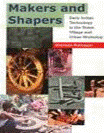|
 Makers and shapers : early Indian technology in the household, village, and urban workshop
Makers and shapers : early Indian technology in the household, village, and urban workshop
By, Ratnagar, Shereen
Publisher: Tulika Books
Class No.: 609.34 RAT
Accession No.: 021960
Year: 2007
Pages: 336 p.
Of the week: 03rd Aug. 2009 to 08th Aug. 2009
"This is a study of technology as self-help endeavour in the home and the provisioning of the household; as work in the rural workshop that supplies pots or iron tools for the village; and as techniques mastered in the urban workshop, feasible not in simple tribal villages but when new production institutions emerge with the development of a political hierarchy. The reader is taken from the agricultural field to the building of the home (with its food-processing and storage facilities), to urban water supply techniques and transport mechanisms, to the use of stone, bronze and iron for tools and weapons. A glimpse is afforded of the difference between the making of pottery by hand and the use of the potter's wheel. The social circumstances required of pottery production are in turn contrasted with those required of metallurgy. The whole is based on archaeological evidence of the Neolithic to Iron Age cultures of South Asia, and, concurrently, on observations of some technological processes followed by villagers today.
In the course of this exploration many points have come up for us to ponder. Sometimes it is the nature of the tools available that could have made possible the use of materials such as certain semi-precious stones or ivory. Which were the craft technologies that depended on bronze tools in the Indus cities? Else, it may have been horse-riding that prompted chiefs of Southern India to sponsor the production of new kinds of iron weapons. It is, besides, possible that the charcoal requirements of early iron-smelting and forging are connected with localized deforestation, and that this had a role to play in the organization and dispersal of the industry. Why were masonry wells so rare after the Indus Valley Civilization? Why is glass production known in the Bronze Age of Western Asia but in the Iron Age of South Asia? In what economic circumstances did people begin to use wheeled transport?
Technology is not viewed here as a self-generating phenomenon. Instead, some puzzles are explained in this book by social and economic factors such as the nature of the work group and the resultant production process, and by political structures as well.
|

